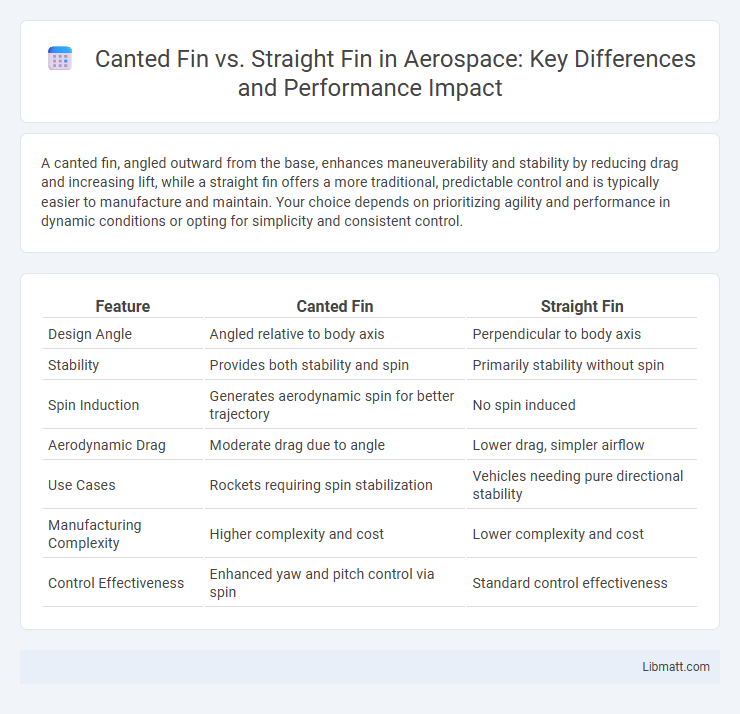A canted fin, angled outward from the base, enhances maneuverability and stability by reducing drag and increasing lift, while a straight fin offers a more traditional, predictable control and is typically easier to manufacture and maintain. Your choice depends on prioritizing agility and performance in dynamic conditions or opting for simplicity and consistent control.
Table of Comparison
| Feature | Canted Fin | Straight Fin |
|---|---|---|
| Design Angle | Angled relative to body axis | Perpendicular to body axis |
| Stability | Provides both stability and spin | Primarily stability without spin |
| Spin Induction | Generates aerodynamic spin for better trajectory | No spin induced |
| Aerodynamic Drag | Moderate drag due to angle | Lower drag, simpler airflow |
| Use Cases | Rockets requiring spin stabilization | Vehicles needing pure directional stability |
| Manufacturing Complexity | Higher complexity and cost | Lower complexity and cost |
| Control Effectiveness | Enhanced yaw and pitch control via spin | Standard control effectiveness |
Introduction to Canted and Straight Fins
Canted fins are angled backward from the body, offering improved aerodynamics and maneuverability compared to straight fins, which extend perpendicularly. Your choice between canted and straight fins impacts stability and control, with canted designs favoring dynamic turns and straight fins providing straightforward lift. These differences influence performance based on usage, whether in aviation, swimming gear, or propulsion systems.
Design Principles of Canted Fins
Canted fins feature angled surfaces optimized to enhance aerodynamic stability and reduce drag compared to straight fins, which are aligned perpendicularly to the rocket body. Their design principles focus on balancing lift and side forces to improve control during flight, utilizing precise cant angles to optimize airflow deflection and minimize turbulence. You can achieve better maneuverability and stability by selecting canted fins tailored to your rocket's velocity and flight profile.
Structural Features of Straight Fins
Straight fins exhibit uniform thickness and perpendicular alignment to the base surface, providing straightforward manufacturing and consistent aerodynamic performance. Their structural simplicity contributes to enhanced mechanical strength and ease of attachment, reducing stress concentrations often encountered in complex fin designs. These fins typically feature streamlined edges that minimize drag while maintaining effective heat dissipation in thermal applications.
Aerodynamic Performance Comparison
Canted fins provide enhanced aerodynamic stability by reducing drag and improving lift-to-drag ratio compared to straight fins, which tend to create more turbulence and drag due to perpendicular airflow impact. The angled design of canted fins smoothens airflow transition, increasing overall flight efficiency and accuracy. Your rocket or missile benefits from better control and longer range when utilizing canted fin configurations.
Effects on Stability and Control
Canted fins improve stability and control by generating aerodynamic forces that create a torque, helping the missile maintain its desired trajectory while reducing unwanted roll. Straight fins provide straightforward, predictable aerodynamic stability but may lead to higher drag and less efficient control at high speeds. The canted design enhances maneuverability by balancing lift and drag forces, resulting in smoother turns and improved overall flight stability.
Impact on Range and Accuracy
Canted fins improve projectile range and accuracy by stabilizing the round through induced spin, reducing drag and increasing aerodynamic efficiency. Straight fins provide basic stabilization but often result in lower accuracy and shorter effective range due to less aerodynamic control. Optimizing fin angles is crucial for achieving maximum projectile performance in various ballistic applications.
Manufacturing Considerations
Canted fins require precise angle control and more complex tooling during manufacturing compared to straight fins, which are simpler to produce due to their uniform shape. The increased complexity of canted fins can lead to higher production costs and longer fabrication times. Optimizing your manufacturing process for canted fins involves balancing these factors against the aerodynamic benefits they offer.
Application in Missiles and Rockets
Canted fins provide enhanced aerodynamic stability and maneuverability in missiles and rockets by creating controlled spin, improving trajectory accuracy in high-speed flight. Straight fins offer simpler design and manufacturing advantages, delivering reliable stability primarily in subsonic or lower supersonic speeds. Your choice between canted and straight fins depends on the desired flight characteristics and control precision for the specific missile or rocket application.
Cost and Maintenance Differences
Canted fins often require more complex manufacturing processes, leading to higher initial costs compared to straight fins, which are simpler and less expensive to produce. Maintenance for canted fins can be more demanding due to their angled orientation causing potential debris accumulation and uneven wear, whereas straight fins typically offer easier cleaning and more uniform durability. Overall, straight fins present a cost-effective and low-maintenance solution ideal for budget-sensitive applications.
Choosing the Right Fin Configuration
Choosing the right fin configuration depends on water conditions and swimming style. Canted fins offer improved maneuverability and reduced drag, making them ideal for dynamic environments and agile swimmers. Straight fins provide better propulsion and stability, suitable for long-distance swimming and slower pace activities.
canted fin vs straight fin Infographic

 libmatt.com
libmatt.com